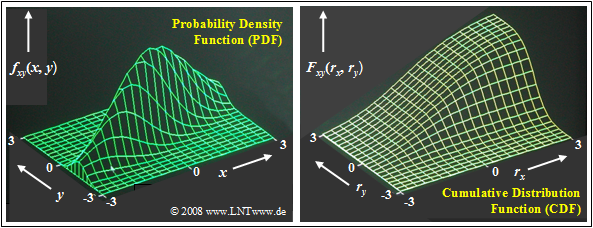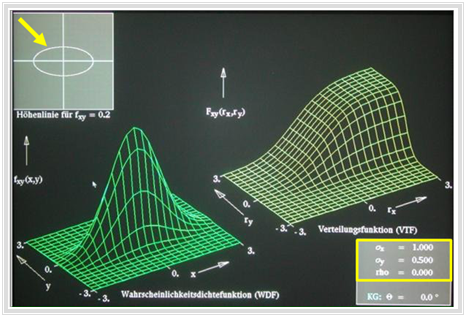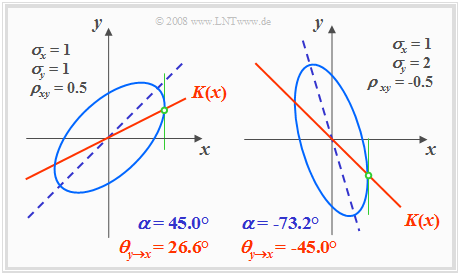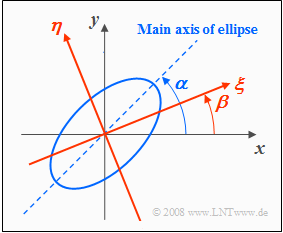Contents
PDF and CDF
All previous statements of the fourth main chapter "Random Variables with Statistical Dependence" apply in general.
For the special case Gaussian random variables' - the name goes back to the scientist Carl Friedrich Gauss - we can further note:
- The composite probability density function of a Gaussian 2D random variable $(x, y)$ with mean values $m_x = 0$, $m_y = 0$ and correlation coefficients $ρ_{xy}$ is:
- $$f_{xy}(x, y)=\frac{\rm 1}{\rm 2\it\pi \cdot \sigma_x \cdot \sigma_y \sqrt{\rm 1-\rho_{\it xy}^2}}\cdot\exp\Bigg[-\frac{\rm 1}{\rm 2 (1- \it\rho_{xy}^{\rm 2} {\rm)}}\cdot(\frac {\it x^{\rm 2}}{\sigma_x^{\rm 2}}+\frac {\it y^{\rm 2}}{\sigma_y^{\rm 2}}-\rm 2\it\rho_{xy}\cdot\frac{x \cdot y}{\sigma_x \cdot \sigma_y}\rm ) \rm \Bigg].$$
- Replacing $x$ by $(x - m_x)$ and $y$ by $(y- m_y)$, we obtain the more general PDF of a two-dimensional Gaussian random variable with mean.
- The two marginal probability density functions $f_{x}(x)$ and $f_{y}(y)$ of a 2D Gaussian random variable are also Gaussian with rms $σ_x$ and $σ_y$, respectively.
- For uncorrelated components $x$ and $y$ in the above equation $ρ_{xy} = 0$ must be substituted, and then the result is obtained:
- $$f_{xy}(x,y)=\frac{1}{\sqrt{2\pi}\cdot\sigma_{x}} \cdot\rm e^{-\it {x^{\rm 2}}\hspace{-0.08cm}/{\rm (}{\rm 2\it\sigma_{x}^{\rm 2}} {\rm )}} \cdot\frac{1}{\sqrt{2\pi}\cdot\sigma_{\it y}}\cdot e^{-\it {y^{\rm 2}}\hspace{-0.08cm}/{\rm (}{\rm 2\it\sigma_{y}^{\rm 2}} {\rm )}} = \it f_{x} \rm ( \it x \rm ) \cdot \it f_{y} \rm ( \it y \rm ) .$$
$\text{Conclusion:}$ In the special case of a 2D random variable with Gaussian PDF $f_{xy}(x, y)$ uncorrelatedness also directly follows statistical independence:
- $$f_{xy}(x,y)= f_{x}(x) \cdot f_{y}(y) . $$
Please note:
- In no other PDF can uncorrelatedness be used to infer statistical independence .
- However, one can always ⇒ infer uncorrelatedness from statistical independence for any 2D PDF $f_{xy}(x, y)$ because:
- If two random variables $x$ and $y$ are completely (statistically) independent of each other, then of course there are no linear dependencies between them
⇒ they are then also uncorrelated.
$\text{Example 1:}$ The two graphs show.
- the probability density function (left) and
- distribution function (right)
of a two-dimensional Gaussian random variable $(x, y)$ with relatively strong positive correlation of the individual components: $ρ_{xy} = 0.8$.
As in the previous examples, the 2D random variable is more extended in $x$ direction than in $y$ direction: $σ_x = 2 - σ_y$.
These representations can be interpreted as follows:
- The PDF here is comparable to a mountain ridge extending from the lower left to the upper right.
- The maximum is at $m_x = 0$ and $m_y = 0$. This means that the the 2D random variable is mean-free.
- The 2D CDF as the integral in two directions over the 2D PDF increases continuously from lower left to upper right from $0$ to $1$ .
The interactive applet PDF and CDF for 2D Gaussian random variables allows plotting the two-dimensional functions for arbitrary values of $σ_x, \ σ_y$ and $ρ_{xy}$.
From the conditional equation $f_{xy}(x, y) = \rm const.$ the contour lines of the PDF can be calculated.
If the components $x$ and $y$ are uncorrelated $(ρ_{xy} = 0)$, the equation obtained for the contour lines is:
- $$\frac{x^{\rm 2}}{\sigma_{x}^{\rm 2}}+\frac{y^{\rm 2}}{\sigma_{y}^{\rm 2}} =\rm const.$$
In this case, the contour lines describe the following figures:
- Circles $($falls $σ_x = σ_y$, green curve$)$, or
- Ellipses $($for $σ_x ≠ σ_y$, blue curve$)$ in alignment of the two axes.
$\text{Example 2:}$
- More information on this topic with signal examples is provided in the first part "Gaussian random variables without statistical bindings" of the learning video (German).
- The graphic shows a snapshot of this learning video.
- The second part covers "Gaussian random variables with statistical bindings" according to the following section
.
For correlated components $(ρ_{xy} ≠ 0)$ the PDF contour lines are always elliptic, thus also for the special case $σ_x = σ_y$.
Here the equation of determination of the PDF contour lines is:
- $$f_{xy}(x, y) = {\rm const.} \hspace{0.5cm} \rightarrow \hspace{0.5cm} \frac{x^{\rm 2} }{\sigma_{x}^{\rm 2}}+\frac{y^{\rm 2} }{\sigma_{y}^{\rm 2} }-{\rm 2}\cdot\rho_{xy}\cdot\frac{x\cdot y}{\sigma_x\cdot \sigma_y}={\rm const.}$$
The following graph shows in lighter blue two contour lines for different parameter sets, each with $ρ_{xy} ≠ 0$.
- The ellipse major axis is dashed in dark blue.
- The correlation line $K(x)$ is drawn in red throughout.
Based on this plot, the following statements can be made:
- The ellipse shape depends not only on the correlation coefficient $ρ_{xy}$ but also on the ratio of the two standard deviations $σ_x$ and $σ_y$ .
- The angle of inclination $α$ of the ellipse major axis (dashed straight line) with respect to $x$–axis also depends on $σ_x$, $σ_y$ and $ρ_{xy}$ :
- $$\alpha = {1}/{2} \cdot {\rm arctan } \ ( 2 \cdot \rho_{xy} \cdot \frac {\sigma_x \cdot \sigma_y}{\sigma_x^2 - \sigma_y^2}).$$
- The (red) correlation line $y = K(x)$ of a Gaussian 2D random variable always lies below the (blue dashed) ellipse major axis.
- $K(x)$ can also be constructed geometrically from the intersection of the contour lines and their vertical tangents, as indicated in green in the sketches above.
For more information on this topic, see the learning video (German) Gaussian 2D Random Variables:
- Part 1: Gaussian random variables without statistical bindings,
- Part 2: Gaussian random variables with statistical bindings.
Rotation of the coordinate system
Bei manchen Aufgabenstellungen ist es vorteilhaft, das Koordinatensystem zu drehen, wie in der folgenden Grafik angedeutet:
- Das $(ξ, η)$-Koordinatensystem ist gegenüber dem ursprünglichen $(x, y)$-System um den Winkel $β$ gedreht.
- Dagegen bezeichnet $α$ den Winkel zwischen der Ellipsenhauptachse und der $x$–Achse.
Zwischen den Koordinaten der beiden Bezugssysteme bestehen folgende Zusammenhänge:
- $$\xi = \hspace{0.4cm} \cos (\beta) \cdot x + \sin (\beta) \cdot y \hspace{0.55cm}{\rm bzw. }\hspace{0.5cm} x = \cos (\beta) \cdot \xi - \sin (\beta) \cdot \eta ,$$
- $$\eta = - \sin (\beta) \cdot x + \cos (\beta) \cdot y \hspace{0.5cm}{\rm bzw. }\hspace{0.5cm} y = \sin (\beta) \cdot \xi + \cos (\beta) \cdot \eta .$$
Ist $(x, y)$ eine Gaußsche 2D-Zufallsgröße, so ist die Zufallsgröße $(ξ, η)$ ebenfalls gaußverteilt.
Setzt man die obigen Gleichungen in die 2D-WDF $f_{xy}(x, y)$ ein und vergleicht die Koeffizienten, so erhält man folgende Bestimmungsgleichungen für $σ_x$, $σ_y$ und $ρ_{xy}$ bzw. für $σ_ξ, σ_η$ und $ρ_{ξη}$:
- $$\frac {1}{(1 - \rho_{\xi \eta}^2) \cdot \sigma_\xi^2} = \frac {1}{(1 - \rho_{xy}^2) } \left[ \frac {\cos^2 (\beta)}{\sigma_{x}^2 } + \frac {\sin^2 (\beta)}{\sigma_{y}^2 } - 2 \rho_{xy} \cdot \frac {\sin (\beta) \cdot \cos (\beta)}{\sigma_{x} \cdot \sigma_{y}}\right ] ,$$
- $$\frac {1}{(1 - \rho_{\xi \eta}^2) \cdot \sigma_\eta^2} = \frac {1}{(1 - \rho_{xy}^2) } \left[ \frac {\sin^2 (\beta)}{\sigma_{x}^2 } + \frac {\cos^2 (\beta)}{\sigma_{y}^2 } + 2 \rho_{xy} \cdot \frac {\sin (\beta) \cdot \cos (\beta)}{\sigma_{x} \cdot \sigma_{y}}\right ] ,$$
- $$\frac {\rho_{\xi \eta}}{(1 - \rho_{\xi \eta}^2) \cdot \sigma_\xi\cdot \sigma_\eta}= \frac {1}{(1 - \rho_{xy}^2) } \left[ \frac {\sin (\beta) \cdot \cos (\beta)}{\sigma_{x}^2 } - \frac {\sin (\beta) \cdot \cos (\beta)}{\sigma_{y}^2 } + \frac {\rho_{xy}}{\sigma_{x} \cdot \sigma_{y}} \cdot ( \cos^2( \beta) -\sin^2( \beta)) \right ] .$$
Mit diesen drei Gleichungen können die jeweils drei Parameter der beiden Koordinatensysteme direkt umgerechnet werden, was allerdings nur in Sonderfällen ohne erheblichen Rechenaufwand möglich ist. Es folgt ein Beispiel mit vertretbarem Rechenaufwand.
$\text{Beispiel 3:}$ Wir betrachten eine Gaußsche 2D-WDF mit folgenden Eigenschaften:
- Die Varianzen der beiden Komponenten sind gleich: $σ_x^2 = σ_y^2 = 1$.
- Der Korrelationskoeffizient zwischen $x$ und $y$ ist $ρ_{xy} = 0.5$.
- Der Winkel der Ellipsenhauptachse gegenüber der $x$–Achse beträgt somit $α = 45^\circ$.
Würde man das Koordinatensystem ebenfalls um $β =45^\circ$ drehen, so ergäbe sich wegen $σ_x = σ_y$ und wegen $\sin(β) = \cos(β) = 1/\sqrt{2}$ für den neuen Korrelationskoeffizienten $ρ_{ξη} = 0$ ⇒ unkorrelierte Komponenten.
Die beiden Streuungen – bezogen auf das neue Koordinatensystem – ergäben sich dann entsprechend den beiden ersten Gleichungen zu $σ_ξ = \sqrt{1.5}$ und $σ_η = \sqrt{0.5}$.
Der obigen Skizze ist allerdings nicht $β = α$ zugrundegelegt, sondern $β = α/2$.
- Mit $σ_x = σ_y = 1$, $ρ_{xy} = 0.5$,
- sowie $α = 45^\circ$, $\sin(β) · \cos(β) = \sin(2β)/2 = \sin(α)/2$ und
- $\cos^2(β) - \sin^2(β) = \cos(2β)= \cos(α)$
kann das Gleichungssystem wie folgt dargestellt werden:
- $${\rm (I)}\hspace{0.8cm}\frac {1}{(1 - \rho_{\xi \eta}^2) \cdot \sigma_\xi^2} = \frac {4}{3} \left[ 1 - \frac {1}{2}\cdot {\sin (\alpha) }\right ] = 0.862 ,$$
- $${\rm (II)}\hspace{0.68cm}\frac {1}{(1 - \rho_{\xi \eta}^2) \cdot \sigma_\eta^2} = \frac {4}{3} \left[ 1 + \frac {1}{2}\cdot {\sin (\alpha) }\right ] = 1.805 ,\hspace{0.28cm}\frac {\rm (I)}{\rm (II)}: \frac {\sigma_\eta}{\sigma_\xi} = \sqrt{\frac{0.862}{1.805} }= 0.691,$$
- $${\rm (III)}\hspace{0.54cm}\frac {\rho_{\xi \eta} }{(1 - \rho_{\xi \eta}^2) \cdot \sigma_\xi\cdot \sigma_\eta}= \frac {\rho_{\xi \eta} }{(1 - \rho_{\xi \eta}^2) \cdot \sigma_\xi^2 \cdot 0.691}=\frac {2}{3}\cdot \cos( \alpha) = 0.471.$$
Dividiert man nun die Gleichung $\rm (III)$ durch die Gleichung $\rm (I)$, so erhält man:
- $$ \frac {\rho_{\xi \eta} }{0.691}=\frac {0.471}{0.862}\hspace{0.5cm}\Rightarrow\hspace{0.5cm}{\rho_{\xi \eta} }= 0.378.$$
Die beiden weiteren Parameter des neuen Koordinatensystems ergeben sich nun zu $σ_ξ ≈ 1$ und $σ_η ≈ 0.7$.
Aufgaben zum Kapitel
Aufgabe 4.4Z: Höhenlinien der 2D-WDF
Aufgabe 4.5: 2D-Prüfungsauswertung
Aufgabe 4.6: Koordinatendrehung




